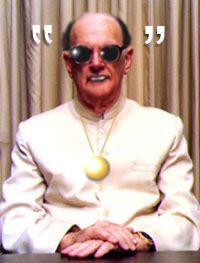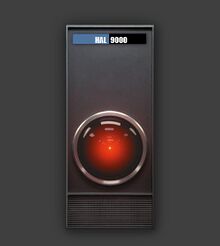Arthur C. Clarke
“If I didn't exist, I would have invented myself.”
Arthur Charles Clarke (16 December 1917 – 19 March 2008) is a world-famous fortune teller who lived much of his life far away from everything (that is, in Sri Lanka) so he could write outlandish science fiction novels. Despite getting help from Stanley Kubrick, Isaac Asimov, and various weird aliens, his literary wit was limited to "Woohoo! Spaceships! Aliens! Spaceships and aliens! In space!!" He became famous in later life as the author of three versions of essentially the same book, and as a guy who looked dreamy-eyed into a camera whilst talking about unexplained phenomena.
Early life
Born in Minehead, England, Clarke grew up daydreaming and doing nothing, which naturally led him to a high-ranking position in the Royal Air Force. After single-handedly winning World War II using radars and articles about satellites, he embarked on a writing career.
Writing
Clarke is the author of numerous science fiction novels, such as Childhood's Beginning, Fountains of Wank, and his groundbreaking novel Rendezvous Without Rama. Because of a massive writer's block, many of his writings were short stories — his best known short story is If I Forget Thee, Oh Earth, about a rather serious case of amnesia.
Clarke's best-known work overall is 2001: A Space Odyssey, which he wrote with Stanley Kubrick back in the 1960s when science fiction films were still young. This was before Star Wars and Star Trek, but not before Plan 9 from Outer Space, thus making it the inspiration for 2001. The result of a frantic and utterly mad writing session by Kubrick and Clarke, the movie was more like an acid trip than a movie. In an attempt to explain the incoherent plot, Clarke wrote a novelisation — that is, a novel based on a movie. Well, why not? The novel explained that the mysterious black monolith was just big bricks that didn't do anything. We also find out the supercomputer HAL 9000 was nothing but a pocket calculator with some poor algorithms.
Another famous Clarke novel is Rendezvous With Rama. The title itself is a tongue-twister, and the novel is an about a massive pipe flying through the solar system, and that's it. There's also Childhood's End about a bunch of uncanny aliens, coming to earth and communicating with humans in a dark room aboard their spaceship, separated by a large glass panel. Wait, isn't that the new film Arrival? Nope, Clarke was there first.
Clarke wrote many, many science fiction stories, and he just couldn't quit. His writings led him to superstar fame, as many a young toddler has read his novels in the local library, and afterward instantly turned into a massive geek.
Clarke's Three Laws
Clarke had three laws, which were added to The Ten Commandments, replacing numbers 1, 2, and 3. They read like this:
- When a distinguished but elderly scientist states that something is possible, he has read too many science fiction stories. When he states that something is impossible, he hasn't read enough science fiction.
- The only way of discovering the limits of the possible is NOT to venture a little way past them into the impossible — instead, stay at home, take acid, and watch 2001 one more time.
- Any sufficiently advanced technology is flippin' mad and should be turned off. My mind is going... I can feel it. I can feel it.
- Clarke's Three Laws only has three laws.
Outlandish claims
Clarke made a large number of claims, which some have linked to his rampant self-absorption. In 1942, he successfully claimed to have invented the typewriter and underwear, whilst less than a year later he claimed water was based on one of his earlier ideas. Among his future predictions was a colony on the moon, space elevator, a utopian society on Earth, and widespread space travel. Have those things happened yet? Well, I'm sure the eggheads are working on it... While we're waiting, we can read some nice science fiction about it.
Clarke-Asimov Treaty
Famous author and robot inventor Isaac Asimov would often come to visit Clarke for a cup of tea. Asimov would try to help Clarke write better stories but to no avail. This led to the Clarke-Asimov Treaty, which was a way of stopping Clarke from committing more crimes against literature and humanity in general. The three laws of the treaty read like this:
- Arthur C. Clarke may not injure a human being or, through inaction, allow a human being to come to harm.
- Arthur C. Clarke must obey the orders given it by human beings except where such orders would conflict with the First Law.
- Arthur C. Clarke must protect his own existence — no, forget about it. Arthur C. Clarke should just jump off a cliff and die! Or move far away! Move to somewhere like, say, Sri Lanka!
Asimov took great advantage of law no. 2 and used Clarke as a personal servant, footstool, and test subject for several sinister scientific projects.
See also
| Featured version: 16 February 2017 | |
| This article has been featured on the main page. — You can vote for or nominate your favourite articles at Uncyclopedia:VFH. | |





